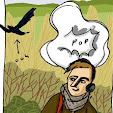This week's advice on better writing for the web included an unexpected moment of poetry, when a poorly designed page was described as an an undifferentiated mess of atomic information items.
The approved style (short sentences, subheadings, single concept, paragraphs chunked to clarity) is drummed into my style nowadays. As a creator of information content, I have to write. But writing, the web tells us is bad; not what the reader wants. We should use as little of it as possible.
This struggle between attention span and communication needs has lead us to a new homogeneity of current web-fashion. The previous, post-tablet, mobile first look I derided as noddy and big buttons has superficially grown up; bright colours are muted, pictures are bought from the classy end of the clip-art collection. But the pictures are very large, and there are almost no words, and destination actions are conspicuously absent, or come with a design shelf that makes it clear that this idea belongs to a previous iteration of the communication object.
This new look, perhaps all pictures, no facts or functions, is in part lead by the templating of the modern web service providers, and in part by a desire to have websites look current uber alles. The straight-out-of-the-box option is so simple, so quick, as fast to set us as an instagram feed; and does even less, until you start to shell out for premium features.
At least the page that is an undifferentiated mass of information items (and I do automatically start thinking about my university site, my authority site when I say this, because damn those sites are confusing until you learn them), but at least that site has information on it.
Beware the sirens of over-optimisation. At the end of the story, you're saying nothing to everybody, endlessly.
The approved style (short sentences, subheadings, single concept, paragraphs chunked to clarity) is drummed into my style nowadays. As a creator of information content, I have to write. But writing, the web tells us is bad; not what the reader wants. We should use as little of it as possible.
This struggle between attention span and communication needs has lead us to a new homogeneity of current web-fashion. The previous, post-tablet, mobile first look I derided as noddy and big buttons has superficially grown up; bright colours are muted, pictures are bought from the classy end of the clip-art collection. But the pictures are very large, and there are almost no words, and destination actions are conspicuously absent, or come with a design shelf that makes it clear that this idea belongs to a previous iteration of the communication object.
This new look, perhaps all pictures, no facts or functions, is in part lead by the templating of the modern web service providers, and in part by a desire to have websites look current uber alles. The straight-out-of-the-box option is so simple, so quick, as fast to set us as an instagram feed; and does even less, until you start to shell out for premium features.
At least the page that is an undifferentiated mass of information items (and I do automatically start thinking about my university site, my authority site when I say this, because damn those sites are confusing until you learn them), but at least that site has information on it.
Beware the sirens of over-optimisation. At the end of the story, you're saying nothing to everybody, endlessly.



